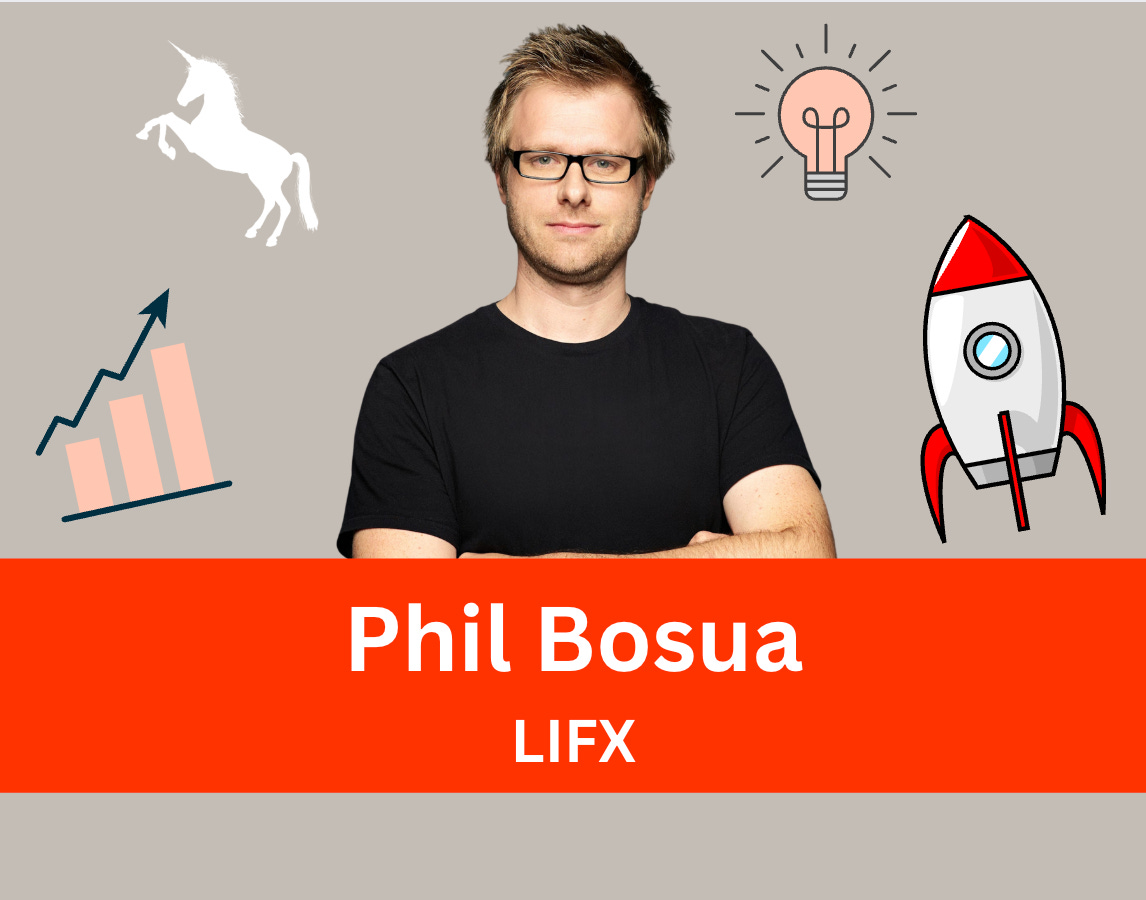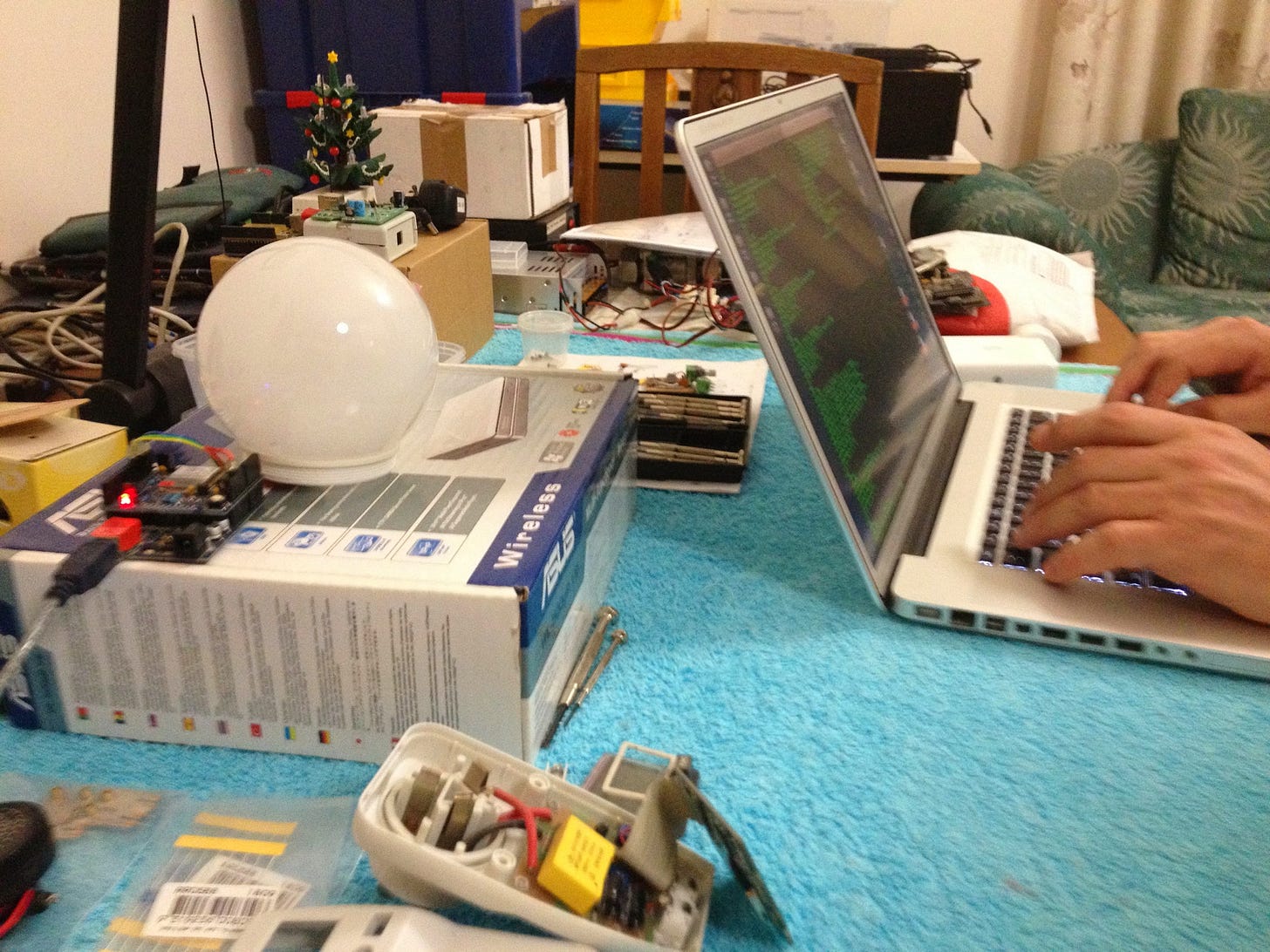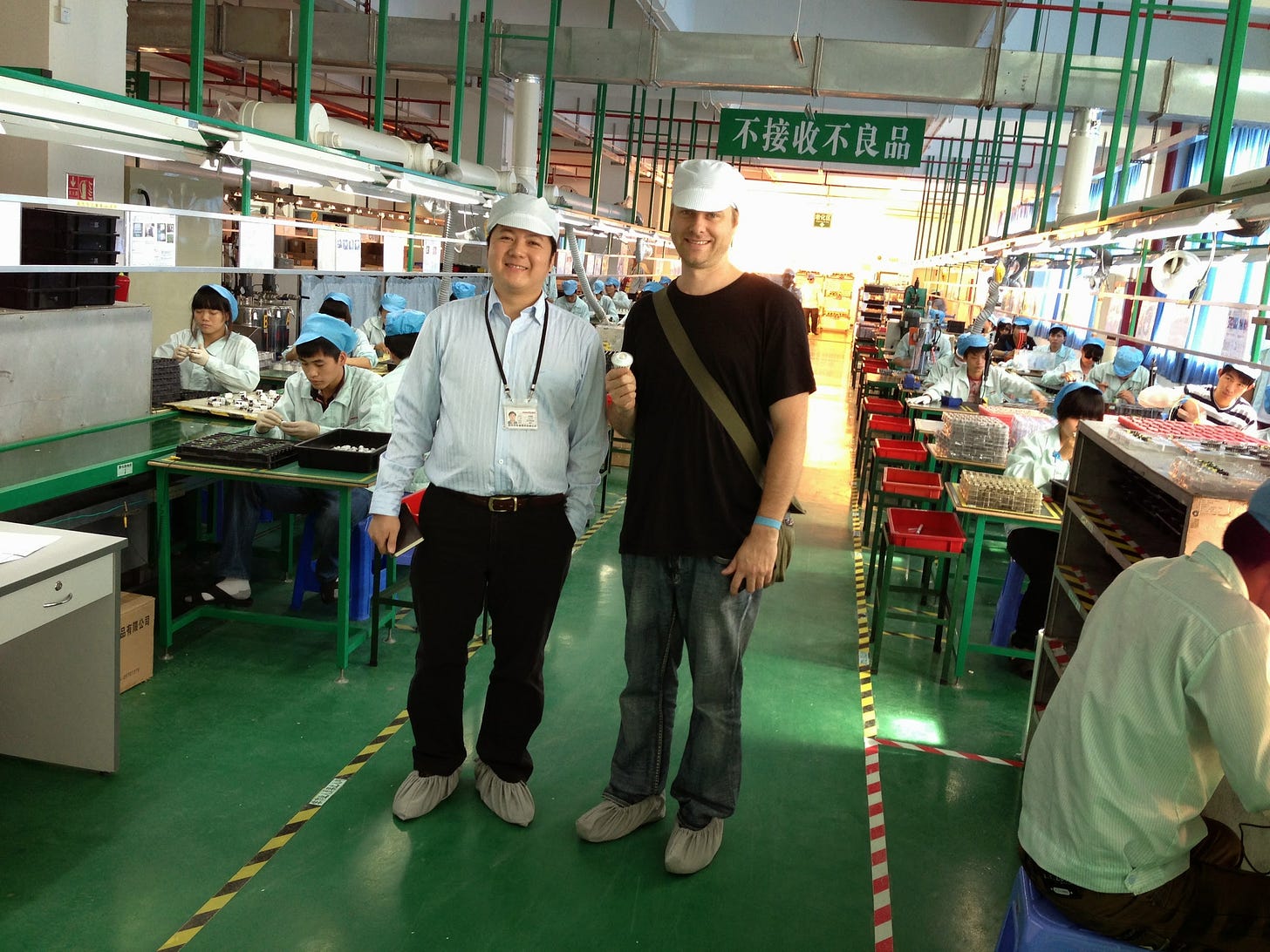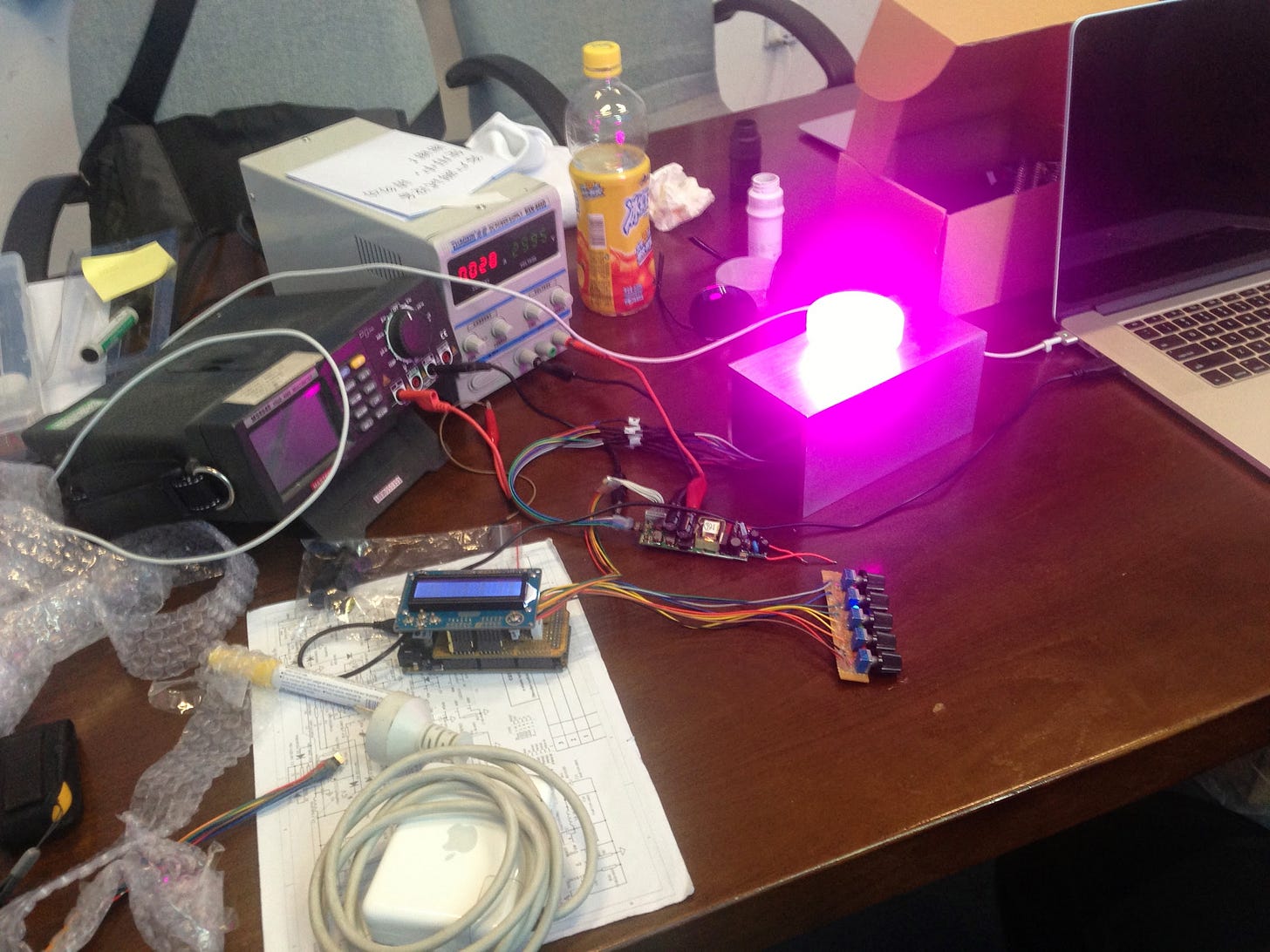Phil Bosua on Reinventing the Light Bulb
Phil Bosua went from electrician to founder of one of the most successful Kickstarter campaigns ever. Then he lost control of his own company. Here's what happened.
Phil Bosua was the CEO and co-founder of LIFX, a company that set out to reinvent the lightbulb. LIFX had one of the more successful Kickstarter campaigns of all time, before going on to raise a Series A from Sequoia. It eventually sold in 2022.
In this interview we cover:
Launching a Kickstarter at 1130pm on a Saturday night
Solving manufacturing challenges on the factory floor in China
Becoming the most “Uber’d” traveller in the world while raising on Sand Hill road
Leaving the company under difficult circumstances
Scott Handsaker (SH): Tell me who Phil Bosua is in 30 seconds or less.
Phil Bosua (PB): Whoever I want to be. I have a very strong feeling that you can make your own reality, so I just make my own reality.
SH: You bend the world to your will?
PB: Yeah. It’s been called a reality distortion field. I’ve had multiple people say that to me. Omar at Sequoia said it once. He was getting worried about something and said to me, “You’re living in a world where you have a reality distortion field.” I just smiled at him. Then he said, “But don’t stop doing it. Just keep doing it!”
I guess one example of this is that I tried to hire a full-time cinematographer at LIFX. Not just anyone, but someone who’d shot the last series of Star Trek. Omar said, “I don’t think you need that.” I’m like, “I’ve got 50 staff at the moment and I’m going to get a Hollywood-level cinematographer to make these light bulbs look beautiful. I think that’s a good idea.”
SH: Did you end up hiring that person?
PB: No, but he’s still one of my best friends.
The Spark
SH: Tell me a little about LIFX?
PB: It was a way to bring creativity into the house.
SH: How did it get started?
PB: I was at a school parents party, maybe 200 people there, pretty rowdy. The host was a Qantas pilot. He goes, “Phil, I’m doing some renos. You’re pretty inventive. I want to run an idea by you.” I was an electrician who had done an apprenticeship. He wanted to cut a chase up a solid plaster wall to get a wire from his switch to the light in the middle of the room. Brickwork dust going everywhere. They’re not fun.
He asks, “Do you know of a way where I can turn that light switch on and off without having to cut a chase in the wall?” I was building IOS apps at the time, so I said, kind of trying to be funny, “Oh, I’m sure there’s an app for that.” I said I’d go home and see if I could find something.
As the night went on and I started going home, I thought that I’m pretty sure I would know if that existed on the App Store. And I don’t think it does. And if it doesn’t, I’m fucking doing that.
SH: What was it about this idea that stood out over the one you were working on?
PB: I showed it to Andrew Birt, who ran the accelerator that I was in, and he goes,
“Phil, I think you’ve reinvented the light bulb.”
And I thought, “Wow, when you think about it like that, that sounds way cooler. And actually, I think you might be right.” It took a few days for this stuff to dawn on me.
Six Weeks to Kickstarter
SH: From the point where you had the idea at the party to putting it up on Kickstarter, how much time had gone by?
PB: Six weeks. It took a week or two to build the prototype with Andy Gelme and my father. But while we were building the prototype, I was doing a hundred other things in parallel. The moment I had an Arduino prototype in my hand that I knew worked, we shot the video within a day or two.
SH: Who were the actual co-founders of LIFX? It always felt like there were quite a few.
PB: Looking back now, I didn’t know what a startup was. I certainly didn’t know what a co-founder was. I came up with the idea for LIFX because I was an electrician. My father got involved because he was an engineer. He was actually the sound engineer for ACDC back in the day. In addition to being an electrician, I was also a lighting technician for rock shows. I knew how all the stuff worked, so I knew I could just jam RGB in there and get 16 million colours out of a single light bulb.
In the first few days it was just me and my Dad. I told him I was going to the hardware store, I’m going to buy a bunch of shit, and then I’m going to rip it all apart and we’re just going to Frankenstein this thing back together. My Dad knew the guy who could do the software. It was a guy called Andy Gelme who was running the Melbourne Hackerspace, and he turned out to be amazing. The three of us got together and Andy said,
“Oh yeah, this is not even hard. I can do this for you.”
My dad made the hardware, Andy’s making the software, and I’m making sure everything they’re building aligns with my vision for this light bulb. Andrew Birt, who was running the accelerator, was also involved 100%. He brought marketing, branding and general startup knowledge. So in terms of co-founders I would say it was me, Andrew, my father, and Andy Gelme.
Jake Lawton gets an honourable mention because he was sitting opposite me in the accelerator as all of this was going on and was just a huge support to me. He took on the role of all the administration. He wasn’t there at the very spark but certainly very quickly after.
SH: Was there any discussion about the role everyone had in the business?
PB: After Kickstarter hit, it was literally like, “Holy shit, who can do what?” And we just split up all the things we had to do. Andrew Birt took a huge burden on with all that. He was filling in a lot of the gaps in the team, while also leading marketing and branding.
The Launch
SH: You did Kickstarter and it was incredibly successful. What was it like in those first few days when it was kicking off?
PB: One of our first investors was Guy King, and he had figured out that Tuesday at 4pm or 10am was the best news cycle time for a Kickstarter to launch. He had done some analytics on it I think. So that was the plan, to launch on a Tuesday.
But we were sitting in a New York apartment on a Saturday night. It was really tiny, and only just fitted three of us. It was about 11:30 at night and we’d just gotten something to eat. We were looking at each other and thinking, everything’s done. There’s literally nothing we can do. We’ve gone over the Kickstarter page so many times. Every video was edited.
And I just went,
“What about if we launched it now?”
11:30 on a Saturday night, possibly the worst time. We just went, “Fuck it,” and launched it.
Within 10 or 15 minutes, we started seeing pledges. Maybe an hour or two in, we’d hit refresh and it’d go up another sale or two. We could literally just hit refresh and the numbers kept going up. We’re like, holy shit. I think we went to bed on like $20,000 or $30,000 or something.
We got up five or six hours later and it was on $50,000. Then it hit the front page of Hacker News and the front page of Reddit. The thing just took off. It got up to $500k the next day.
Then I start getting all these interview requests. I did about 40 interviews in the first 40 hours. I remember at one point, I had just finished an interview for breakfast radio in Melbourne, and I immediately collapsed onto the bed from exhaustion.
SH: That’s quite an introduction to startups from someone who didn’t really know anything about startups?
PB: Yeah.
Brought to you by Murmar
Manufacturing in China
SH: Once the Kickstarter was successful, you had to manufacture this thing. You manufactured in China, and I think you lived there for a bit didn’t you?
PB: I spent three months there in total, but not in a row. The longest was about a month. At the time, people were skeptical that we could build it, but it’s not that hard. You’re using a small chip that has been around for 30 or 40 years. You can just buy a Qualcomm chip or a Texas Instruments chip. Through prototyping on an Arduino, I knew you could turn that into your own circuit board.
So I was never worried whether we’d build it or not. We did have one big hiccup, and my dad and I were the last men standing to solve this problem. It was the heat. The chips that made the bulb affordable to manufacture only ran up to 75°C, and our bulb was operating at 85°C.
It was just my Dad and I who stayed behind in the factory. Everyone else went. The factory couldn’t solve it because they’d never built it. We’re in there with the Solidworks guy trying to troubleshoot it for quite a while. “What happens if you do that? What happens if you do this?”
They were teaching me about the volume of air flow required when it comes to heat. You can’t put the fins too close together, because there’s a gaseous state where air won’t run right next to the heat. I found myself designing a chimney. We ended up making it so that the hot part of the bulb exhausts and just pulls the air up from underneath. You get that bonus of air movement because it’s colder down the bottom. Ultimately, that idea got us over the line with the heat.
Go-to-Market
SH: What was the go-to-market motion like? What did you learn?
PB: During the day-to-day it was difficult to do anything well. But the GTM process was kind of laid out before us because of the Kickstarter success. Best Buy were courting us to launch the physical product on the front page of their catalog. We didn’t have to beg like most startups.
It was hard because we were worldwide shipping at that point, which was a mistake. I wouldn’t do that again. I would just do US, especially if you’re in the US. You don’t want to do worldwide shipping on a brand new idea. But we got through it.
For a period of time, it felt like as many as we could make, we knew we would sell. So it was more about trying to make sure we had stock and that the software and firmware was constantly updating and getting better and more solid.
After we launched the product, we had around $12 million in sales in the first year. We don’t have to have $200 million of sales in our first year, even if we had that demand. I wanted to build it right because I knew if I built it right, there was no ceiling to how big we could get.
The Fundraising Journey
SH: Let’s talk about your fundraising journey. I know you raised some angel money first. Was that before the kickstarter was so successful?
PB: Guy King was our first investor, and he made it possible pre-Kickstarter for me not to go bust on all of my credit cards. He loved what we were doing. We were having a beer at a bar in Richmond and I said,
“I don’t know if you want to do this. If you don’t want to do it, it’s fine. I’ll figure it out. But if you can just chuck 10 grand in, I can just go get all the prototype stuff I need.”
He said, “Done.” That was amazing. Then he put about another $50k in to help us out while we were in the States. He was so generous and inspiring, and he loved the project so much. The time I spent with him were some of my most enjoyable moments at LIFX.
SH: Did you ever do a formalised angel round before you raised the Series A?
PB: Yeah. Guy came to me and said let’s do it. He told his former business partner Bevan about it, and Bevan wanted to jump in as well for the same. So we formalised the seed round just after Kickstarter.
The Sequoia Round
SH: The next round was the Sequoia round. How did that come about?
PB: Andrew and I kept going over to the States because we needed to. I think we’d been like five or six times, dropping into VCs when we went. We’d been to Sequoia maybe four times, and we had dropped into Kleiner Perkins a couple of times.
I was in China at the time and I’d just done an ABC radio interview. Omar Hamoui from Sequoia had caught that interview and reached out again. We went back to the US and we’re sitting in the Sequoia boardroom. Omar said, “All right, this is all good. We love it. We absolutely love it. But we’re getting a little frustrated with you.”
I’m like, “What’s your frustration?” He said, “When are you opening up a round?”
I replied, “Oh yeah. We should do that, shouldn’t we?” So I came back to the team in Australia and told them we were opening up a round.
We agreed to open up a round and we headed back to the US for conversations. Word spreads fairly quickly so we had a lot of meetings lined up. We spent the first week in a hotel in Menlo Park putting the deck together.
I headed up to San Francisco for a party, where I showed the deck to my friend Diesel. He read through it, very patient, and goes, “It’s awesome. But it looks like shit. Why don’t you just make it look good as well?” So I took it away and spent another week just making it look nice. I took out 90% of the words and added lots of pictures, but it communicated the vision better.
Then we did 60 VC meetings in six weeks. Uber had actually started a couple months before, and we found ourselves in San Francisco needing to get to places quickly. We didn’t want to be on calls while driving, so did a lot of Uber. Back then they only had black cars, so it was expensive. At one point, they said I was the most Ubered traveler in the world in the first three months.
Early on in the fundraising, Sequoia said they wanted to do it. They hadn’t given us a term sheet yet, but they told us that they wanted in.
SH: You ended up with multiple term sheets. Did you then have to choose or was it an easy choice?
PB: Yeah, you get the multiple term sheets and you choose. I chose Sequoia.
SH: Was that the last fundraise you did?
PB: We did have a Series B on the table before it went up shit creek.
SH: What did the Series B look like?
PB: It came to me. I didn’t even have a deck. One of the VCs said, “We would like to take the whole thing.” They’d already been talking to Sequoia. Good valuation and everything. The person I was talking to said at the end, “Can you just put me together a deck? If everything you’ve just told me is how it is, we want to do it.”
I said, “Everything I just told you is exactly as it is. So I will get that deck to you.”
That was just before the shit hit the fan.
When Things Fell Apart
SH: What are you referring to there? What happened?
PB: The whole thing was getting a little bit much for me because I was so inexperienced. I’m a quick learner, but I wasn’t happy with where the product was at after about a year of the Sequoia investment. I just wanted to get the product right. That was my passion. I enjoyed all the other stuff, but to me the product mattered the most.
I was starting to murmur that I’d prefer to focus on product. Marc Alexander, who was CTO at the time, came to me and said, “I’ve got an idea. I could be interim CEO while we find a new CEO, and then you focus on product.” I thought that was actually a really good idea.
I talked to Omar at Seqouia about it and he said,
“We think it’s too early for you not to be CEO, but if that’s really what you want to do, we’ll support you and find a CEO for you.”
That’s kind of what I wanted because I’m having to learn about financial charts and millions of dollars of balancing budgets. I’m actually pretty good at doing that, but when I hit waterfall charts, I’m like, really? I just want to make light bulbs and make them look good.
SH: How did that process go?
PB: Marc became interim CEO for a time. Eventually we were interviewing a new CEO that Sequoia found for us. He loved it. He spent two or three hours in a session with me and we got along really well. He said to Omar, “I think Phil’s vision is the type of vision I can get behind. I’d like to do this.”
So then it was time for him to meet the team. Marc was the first person he needed to meet, and Marc didn’t turn up to the meeting. I rang Marc and he said, “Oh, I’m down at Nest. I can’t get away.” I’m like, “No, you can get away from this. Get up here.”
He came up, but the whole thing was flat right from the start. Marc was 45 minutes late and didn’t look interested. Some of the staff started to tell me, “I think he wants to be the CEO.” I thought, “No, no, no. That wasn’t the agreement. Interim CEO, we said maybe six months.”
The company started putting the squeeze on me and telling me I couldn’t do the things that made me who I am. I eventually got an official warning. In the end I thought, go fuck yourselves. This is my company or I’m not involved. And you can see how you go without me. I don’t give a fuck.
That’s basically where it ended up. I resigned. I thought fuck you. You’re telling me what to do. Well, you’re on your own.
SH: Looking back on that, what do you think you missed?
PB: Too trusting. I was too trusting. Totally missed it. Didn’t see it at all.
SH: How much time was there between this happening and the eventual LIFX exit?
PB: I think from that point LIFX started to slowly go downhill over years, until it ended up where it ended up.
SH: Do you remember at the point you left what kind of revenue you were doing?
PB: I left about a year after Sequoia’s investment. I think that was the $12.5M and we were projecting $30M to $40M the next year.
SH: Did you manage to make some money out of it in the end?
PB: Yeah but not as much as it might have been.
SH: If you go back in time, what could you have done differently?
PB: Staff were turned against my way of thinking. They were saying I’m spending too much money, whereas I had investors telling me to spend it faster because they like a big burn. As long as you’re creating value, they don’t mind how much money you’re spending. You want to take whatever money they give you and increase it in value by 10x. I was doing that.
But I was getting labeled internally with statements like “You need to watch your spending,” whereas I’ve got actual investors asking me to spend more!
SH: How were your relationships at that time with your co-founders, and how are they today?
PB: They were in the gutter after the shit hit the fan. It was just a political event and I don’t like politics.
Obviously with my father, everything’s great, but I’ve fallen out with most of those people. I have a theory on it though. It’s when people get involved with my crazy, creative ideas that they get very excited. And given the intensity of the relationship, people are either all-in or the relationship breaks.
Lessons and Reflections
SH: Did any other relationships suffer during the building years that you didn’t expect?
PB: The relationship with my wife at the time. It wasn’t the strain of what we were going through. In fact, it was exciting. We were both excited and the kids were excited. But I relished the growth opportunity that was thrust before us as a family, and my wife at the time did not. That’s fine. People don’t have to grow at the same level.
We were just trucking along doing our Melbourne suburban thing and having a great time, and then this worldwide thing is thrust upon you and you either grow or you don’t. We grew apart.
The Final Wrap Up Questions
SH: What is a book that we should all read?
PB: I’ve never read a book in my life. Genuinely. I got through half of Call of the Wild when I was in primary school. I do read a lot, but I don’t get into the medium of books.
SH: When you say you read a lot, what do you read?
PB: Articles. or I watch research heavy things on YouTube. Physics, science, AI. I could watch five hours of those videos. PBS Spacetime and all that heavy shit. I’m taking in an awful lot of information, but I’ve never read a book.
SH: Well then what is a YouTube channel or show we should all watch?
PB: I would follow Anthropic’s podcast. They do a video podcast and that company is incredible. I’m very impressed.
SH: What is a band or artist we should all listen to?
PB: I’m making AI music at the moment. If you go to soundtrip.app, you can hear it.
SH: Was there anything I should have asked you that I didn’t?
PB: Why did I do it?
SH: Okay. Why did you do it?
PB: I wanted to bring the joy of ambience to people. It can improve your life. Ambience is beautiful. That’s why I wanted to do it.
SH: Did you achieve that?
PB: I think I did. I definitely made some inroads in making people’s environment more beautiful.
SH: Do you currently own and use any LIFX products?
PB: Yes. Always. I have other light bulbs in my house, but the ones I use the most are all LIFX. Absolutely. It’s a great product.








